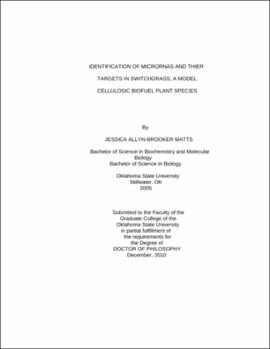| dc.contributor.advisor | Sunkar, Ramanjulu | |
| dc.contributor.author | Matts, Jessica Allyn-Brooker | |
| dc.date.accessioned | 2013-11-26T08:22:55Z | |
| dc.date.available | 2013-11-26T08:22:55Z | |
| dc.date.issued | 2010-12 | |
| dc.identifier.uri | https://hdl.handle.net/11244/6657 | |
| dc.description.abstract | Scope and Method of Study: | |
| dc.description.abstract | Over the past several years, several plant species such as switchgrass, Miscanthus, Sorghum, and Brachypodium have been recognized as potential model plant species for cellulosic bioenergy production. Of these, switchgrass has attracted more attention in the United States, because it can be grown on marginal and wastelands, and it can also tolerate drought and heat stress. Very little is known about the basic biology of the traits that control these important characteristics, including biomass accumulation in switchgrass. Recently discovered miRNAs play an important role in post-transcriptional gene regulation and this regulation is critical for normal plant growth and development, and tolerance to environmental stress conditions including nutrient deprived conditions. To gain an insight into the complex post-transcriptional regulatory network operating in this plant species, we sought to identify the miRNAs and the genes that these miRNAs are regulating in switchgrass. | |
| dc.description.abstract | Findings and Conclusions: | |
| dc.description.abstract | By deep sequencing small RNA libraries from switchgrass, 31 conserved miRNA families, one tasiRNA family, and 15 novel miRNA families have been identified. Interestingly six of the novel miRNAs appears to be conserved in related monocot species. Small RNA blot analysis indicated that some of the conserved and novel miRNAs are expressed in a tissue-specific manner, although most are ubiquitously expressed. Surprisingly, unlike in Arabidopsis and other plants, miR395 and miR399 expression levels were not regulated in response to sulfate or phosphate-deprived conditions. Thirty-seven genes are predicted as targets for miRNAs, and several mRNAs (Squamosa promoter binding-like factor, apetala2 like, NAC domain containing transcription factor, and HD-ZIP homologs) were validated using 5'-RACE assays. Additionally, 45 genes are predicted as targets for novel miRNAs in switchgrass. Identification of large set of miRNAs and their targets laid the foundation for functional genomic approaches in switchgrass. | |
| dc.format | application/pdf | |
| dc.language | en_US | |
| dc.rights | Copyright is held by the author who has granted the Oklahoma State University Library the non-exclusive right to share this material in its institutional repository. Contact Digital Library Services at lib-dls@okstate.edu or 405-744-9161 for the permission policy on the use, reproduction or distribution of this material. | |
| dc.title | Identification of micrornas and their targets in switchgrass, a model cellulosic biofuel plant species | |
| dc.contributor.committeeMember | Melcher, Ulrich | |
| dc.contributor.committeeMember | Mahalingam, Ramamurthy | |
| dc.contributor.committeeMember | Wu, Yanqi | |
| osu.filename | Matts_okstate_0664D_11106 | |
| osu.accesstype | Open Access | |
| dc.type.genre | Dissertation | |
| dc.type.material | Text | |
| dc.subject.keywords | microrna | |
| dc.subject.keywords | switchgrass | |
| thesis.degree.discipline | Biochemistry and Molecular Biology | |
| thesis.degree.grantor | Oklahoma State University | |
